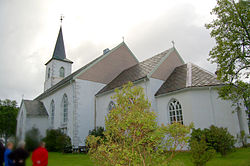| Ibestad Church | |
|---|---|
| Ibestad kirke | |
 View of the church | |
 | |
| 68°47′15″N17°09′15″E / 68.7875757°N 17.1542340°E | |
| Location | Ibestad Municipality, Troms |
| Country | Norway |
| Denomination | Church of Norway |
| Churchmanship | Evangelical Lutheran |
| History | |
| Status | Parish church |
| Founded | 13th century |
| Consecrated | 1881 |
| Architecture | |
| Functional status | Active |
| Architect(s) | J. A. Johansen |
| Architectural type | Long church |
| Style | Neo-Gothic |
| Completed | 1881 |
| Specifications | |
| Capacity | 500 |
| Materials | Stone |
| Administration | |
| Diocese | Nord-Hålogaland |
| Deanery | Trondenes prosti |
| Parish | Ibestad |
| Type | Church |
| Status | Listed |
| ID | 84709 |
Ibestad Church (Norwegian : Ibestad kirke) is a parish church of the Church of Norway in Ibestad Municipality in Troms county, Norway. It is located in the village of Hamnvik in eastern part of the island of Rolla. It is the main church for the Ibestad parish which is part of the Trondenes prosti (deanery) in the Diocese of Nord-Hålogaland. The white, stone, neo-Gothic church was built in a long church style in 1881 using plans drawn up by the architect J.A. Johansen from Trondheim. The church seats about 500 people. [1] [2]